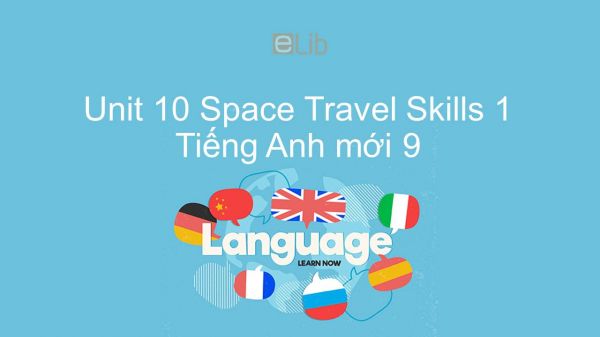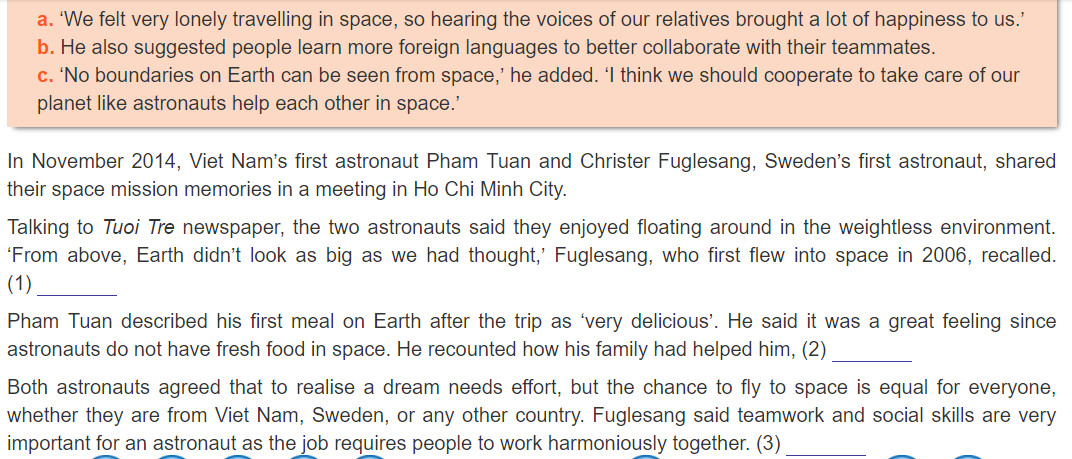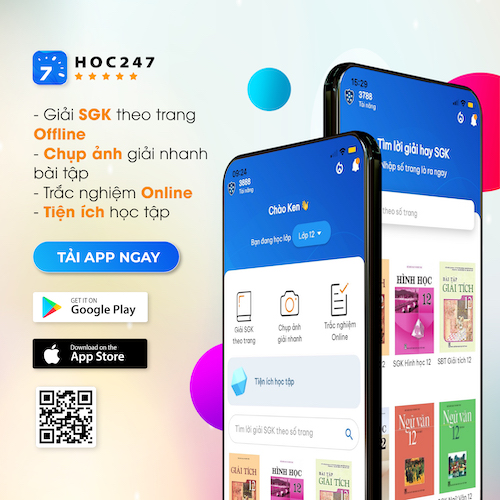Unit 10 lớp 9: Space Travel - Skills 1
Phần Skills 1 - Unit 10 giúp các em rèn luyện hai kĩ năng quan trọng trong tiếng Anh là Reading và Speaking. Với các bài tập khác nhau, các em được đọc hiểu về những trải nghiệm của hai phi hành gia, luyện tập thảo luận với các bạn về các phẩm chất cần có của các phi hành gia và cách giải quyết các vấn đề xảy ra trong tàu không gian.
Mục lục nội dung

Unit 10 lớp 9: Space Travel - Skills 1
1. Reading
1.1. Task 1 Unit 10 lớp 9
Do you recognise the Vietnamese astronaut in these photos? Discuss with a partner what you know about him. Then turn the page around and read the Quick Facts box. (Bạn có nhận ra phi hành gia Việt Nam trong những bức ảnh này? Thảo luận với bạn cùng học điều bạn biết về ông ấy. Sau đó xoay ngược trang để đọc khung Quick Facts)

Tạm dịch:
Phạm Tuân
- sinh năm 1947 tại Thái Bình
- người Việt Nam đầu tiên và người Châu Á đầu tiên bay vào không gian
- sứ mệnh trên Soyuz 37, chương trình nghiên cứu phi hành gia Intercosmos năm 1980
- tiêu đề "Người hùng của Việt Nam và anh hùng lực lượng vũ trang nhân dân" và "Người hùng của Liên Xô"
1.2. Task 2 Unit 10 lớp 9
Read the text and do the exercises. (Đọc và làm bài tập)
a. Place these sentences in appropriate paragraphs. (Đặt những câu này vào đoạn văn phù hợp)

Guide to answer
1. c 2. a 3. b
Tạm dịch:
Tháng 11 năm 2014, phi hành gia đầu tiên của Việt Nam Phạm Tuân và Christer Fuglesang, phi hành gia đầu tiên của Thụy Điển, đã chia sẻ những kỉ niệm về sứ mệnh không gian của họ trong một cuộc họp tại Thành phố Hồ Chí Minh.
Trò chuyện với báo Tuổi Trẻ, hai phi hành gia cho biết họ rất thích bay lơ lửng trong môi trường không trọng lượng. Fuglesang, người lần đầu tiên bay vào vũ trụ năm 2006, nhớ lại: “Nhìn từ trên cao, Trái đất không lớn như chúng ta nghĩ. "Không có ranh giới nào trên Trái đất có thể được nhìn thấy từ không gian," ông ấy nói thêm. "Tôi nghĩ chúng ta nên hợp tác để quan tâm hành tinh của chúng ta giống như các phi hành gia giúp đỡ nhau trong không gian."
Phạm Tuân đã miêu tả bữa ăn đầu tiên trên Trái đất sau chuyến đi là "rất ngon". Ông nói đó là một cảm giác tuyệt vời vì các phi hành gia không có thức ăn tươi trong không gian. Ông kể lại gia đình đã giúp đỡ ông như thế nào, "Chúng tôi cảm thấy rất cô đơn khi du hành trong không gian, vì vậy việc nghe thấy giọng nói của những người thân đã mang lại rất nhiều hạnh phúc cho chúng tôi."
Cả hai phi hành gia đều đồng ý rằng để thực hiện được ước mơ cần có sự nỗ lực, nhưng cơ hội bay vào không gian là bình đẳng cho tất cả mọi người, dù cho họ đến từ Việt Nam, Thụy Điển hay bất kỳ quốc gia nào khác. Fuglesang cho biết tinh thần đồng đội và các kĩ năng xã hội là rất quan trọng đối với một phi hành gia vì công việc đòi hỏi mọi người phải làm việc một cách hài hòa với nhau. Ông ấy cũng đề nghị mọi người học thêm ngoại ngữ để cộng tác tốt hơn với đồng đội.
b. Answer the questions (Trả lời những câu hỏi)
1. Who is Pham Tuan and who is Christer Fuglesang? (Phạm Tuân và Christer Fuglesang là ai?)
2. What did Fuglesang think when he looked at Earth from space?
(Fuglesang đã nghĩ gì khi nhìn Trái Đất từ không gian?)
3. Do you think Pham Tuan enjoyed the food aboard the spacecraft? Why/why not?
(Bạn có nghĩ rằng Phạm Tuân thích thức ăn trên tàu vũ trụ? Vì sao?)
4. How did Pham Tuan's family help him while he was in space?
(Gia đình Phạm Tuân đã giúp ông như thế nào khi ông trong không gian?)
5. What do the two astronauts think about the chance to fly into space?
(Hai phi hành gia nghĩ gì về cơ hội bay trong không gian?)
6. What skills does Fuglesang think are important for an astronaut?
(Fuglesang nghĩ lỹ năng nào là quan trọng cho một phi hành gia?)
Guide to answer
1. Pham Tuan is Viet Nam's first astronaut, and Christer Fuglesang is Sweden's first astronaut.
(Phạm Tuân là phi hành gia đầu tiên của Việt Nam, và Christer Fuglesang là phi hành gia đầu tiên của Thụy Điển.)
2. He found that Earth didn't look as big as he thought, no boundaries on Earth could be seen from space we should cooperate to take care of it.
(Anh ta thấy rằng Trái đất không lớn như anh nghĩ, không có ranh giới nào trên trái đất có thể nhìn thấy từ không gian chúng ta nên cùng nhau để chăm sóc nó.)
3. It seemed he didn't enjoy it much since it wasn't fresh.
(Có vẻ như không thích nó vì nó không trong sạch.)
4. They talked to him when he was in space and that made him happy.
(Họ nói chuyện với anh ta khi anh ta ở trong không gian và làm anh ta hạnh phúc.)
5. They think the chance to fly to space is equal for everyone.
(Họ nghĩ rằng cơ hội để bay vào vũ trụ là bình đẳng cho tất cả mọi người.)
6. He thinks teamwork, social skills, and foreign languages are important for an astronaut.
(Ông nghĩ rằng làm việc nhóm, kỹ năng mềm, và ngoại ngữ là quan trọng đối với một phi hành gia.)
2. Speaking
2.1. Task 3 Unit 10 lớp 9
Discuss with your partner the qualities and skills that you think are necessary for an astronaut today. You may look again A CLOSER LOOK 1, Activity 2 for more ideas. (Thảo luận với bạn cùng học những phẩm chất và kỹ năng mà bạn nghĩ cần thiết cho một phi hành gia ngày nay. Bạn có thể xem lại A CLOSER LOOK 1, Activity 2 để có thêm ý tưởng)
Guide to answer
- They must pass a physical test similar to a military physical. (Họ phải vượt qua một bài kiểm tra cơ thể tương tự như ở quân sự)
- Astronauts need a bachelor’s degree from an accredited university in engineering, biological science, physical science or math. (Các phi hành gia cần có bằng cử nhân từ một trường đại học được công nhận về kỹ thuật, khoa học sinh học, khoa học tự nhiên hoặc toán học)
- Astronauts need quick thinking to handle unexpected problems. (Phi hành gia cần nhanh chóng suy nghĩ để giải quyết những vấn đề bất ngờ.)
- They must be open-minded to diversity because they work on teams with astronauts from other countries and cultures. (Họ phải cởi mở với sự đa văn hóa bởi vì họ làm việc cùng các đội có phi hành gia từ các quốc gia và nền văn hóa khác nhau.)
- They must also grapple with isolation, fear and separation from loved ones. (Họ cũng phải vật lộn với sự cô lập, sợ hãi và xa cách với người thân.)
2.2. Task 4 Unit 10 lớp 9
Working harmoniously... (Hoạt động hài hòa ...)
You are in a spacecraft and suddenly these problems happen. Work with your members to solve them.(Bạn đang ở trong một tàu không gian và đột nhiên có vấn đề xảy ra. Làm việc với các thành viên để giải quyết vấn đề)
One crew member feels extremely homesick.
When looking at the monitoring system you discover a strange object approaching Earth.
Guide to answer
- One crew member feels extremely homesick:
- She/ He can make phone calls to family and friends on Earth.
- She/ He can exercise, read a book, listen to music, or play some games.
- Other crew members can talk to her/ him, or together they can do something fun in their free time, for example having a ‘space party’.
- When looking at the monitoring system you discover a strange object approaching Earth:
- The crew can contact the Mission Control Centre for help.
- They can start watching the object, record its movements, and report back to Earth.
Tạm dịch:
- Một thành viên trong đoàn cảm thấy rất nhớ nhà
- Cô ấy/ Anh ấy có thể gọi về nhà và bạn bè ở Trái Đất
- Cô ấy/ Anh ấy có thể tập thể dục, đọc sách, nghe nhạc, chơi game
- Các thành viên còn lại có thể trò chuyện với anh/ cô ấy hoặc cùng làm gì đó vui vui trong thời gian rảnh, ví dụ tổ chức tiệc trong không gian
- Khi nhìn vào hệ thống giám sát bạn phát hiện một vật thể lạ đang tiến đến gần Trái Đất
- Phi hành đoàn liên lạc với Trung tâm kiểm soát nhờ giúp đỡ
- Họ có thể bắt đầu xem vật thể, ghi nhận chuyển động của nó, và báo cáo lại Trái Đất
3. Practice Task 1
Choose the word or phrase among A, B, C or D that best fits the blank space in the following passage.
Neil Armstrong was the first person (1)…….. on the moon. He was born in Ohio on August 5, 1930. While he was in college, he left to serve in the U.S. Navy. He flew planes during the Korean War. Then he came back to college and finished the degree he (2)……... He later (3)…….. a master's degree too.
Armstrong became an astronaut in 1962. He was the commander of Gemini 8 in 1966. Neil Armstrong (4)…….. the first successful connection of two vehicles in space.
Armstrong’s second flight was Apollo 11 in 1969, and he was the mission commander. He flew with Buzz Aldrin and Michael Collins. Armstrong and Aldrin landed on the moon in a lunar module named "Eagle". With more than half a billion people (5)…….. on television, Armstrong (6)……… the ladder and said, "That's one small step for a man, one giant leap for mankind." and Aldrin (7)……. him shortly. They explored the surface for two and a half hours, collecting samples and taking photographs.
They left behind an American flag, and a plaque reading, "Here men from the planet Earth first (8)………..upon the moon. July 1969 A.D. We came in (9)…….for all mankind."
After almost a day, they blasted off. They docked with Collins in (10)……….around the noon. All three then flew back to the Earth.
Question 1: A. walk B. walking C. to walk D. walked
Question 2: A. starts B. started C. would start D. had started
Question 3: A. took B. make C. earned D. scored
Question 4: A. performed B. operated C. functioned D. carried
Question 5: A. watch B. to watch C. watching D. watched
Question 6: A. lowered B. climbed down C. descended D. stepped
Question 7: A. joined B. connected C. joined in D. involved
Question 8: A. went B. set a foot C. set food D. set feet
Question 9: A. silence B. freedom C. communication D. peace
Question 10: A. space B. orbit C. height D. distance
4. Practice Task 2
Read the passage, and choose the correct answer A, B, C or D for each question.
The Shuttle Era Comes to an End
The set of Space Shuttle missions run by NASA captivated the world and proved that reusable spacecraft could be used to bring astronauts and cargo into space. The Space Shuttle programme had a total of six separate orbiters, five of which actually went into space. The first-made orbiter was only used to gather data about how the shuttles would glide back to the earth. This shuttle would be brought up into the air by a specially modified Boeing 747 and released to glide down without any power of its own.
The Space Shuttle Era ran from the first launch on April 12, 1981, and ended when the final shuttle landed on July 21, 2011. During this time, there were 135 missions flown. Of the five shuttles that did go into space, two met with disasters that killed all the crew members aboard.The first disaster happened on January 28, 1986 when Space Shuttle Challenger ran into severe problems and exploded less than two minutes after take-off. It was a major blow to NASA as a school teacher was on board the orbiter, and the launch was being watched by children from schools across the United States. The second disaster came on February 1, 2003. After having completed its mission, Space Shuttle Columbia was returning to the earth from space. During damage done to a wing during its launch, the orbiter disintegrated as it hit the earth’s atmosphere during re-entry.
Because the Space Shuttle programme was running, it largely made possible the construction of the International Space Station (ISS). The shuttles brought astronauts to the station, replenished supplies, and carried actual pieces to the Space Station up from the earth.As the Space Shuttle Era came to an end, many space lovers have been left wondering, “What’s next?” There is still plenty to explore, so we will all just have to wait and see.
Question 1: What was captivated in the passage?
A. The world B. An astronaut C. A mission D. A space shuttle
Question 2: How many orbiters are there in the Space Shuttle programme mentioned in the passage?
A. Four B. Five C. Six D. Seven
Question 3: What were considered to be unfortunate?
A.The supplies B.The disasters
C. The Space Stations D.The different eras
Question 4: When did the second disaster take place?
A. 1981 B. 1986 C. 2003 D. 2011
Question 5: Who was mentioned as being on board the Space Shuttle Challenger?
A. A doctor B. A teacher C. A reporter D. A scientist
5. Conclusion
Kết thúc bài học các em cần luyện đọc và trả lời câu hỏi, luyện tập thảo luận về những phẩm chất và kĩ năng cần có của một phi hành gia; đồng thời ghi nhớ các từ vựng sau:
- float around: trôi nổi
- weightless environment: môi trường không trọng lực
- recall (v): hồi tưởng, nhớ lại
- describe (v): miêu tả
- cooperate (v): hợp tác
- collaborate with: hợp tác
- take care of: chăm sóc
- boundary (n): đường biên giới
- efford (n): nỗ lực
- teamwork: làm việc nhóm
- social skills: kĩ năng xã hội
- harmoniously (adv): một cách hòa đồng
Tham khảo thêm
- doc Unit 10 lớp 9: Space Travel - Getting Started
- doc Unit 10 lớp 9: Space Travel - A Closer Look 1
- doc Unit 10 lớp 9: Space Travel - A Closer Look 2
- doc Unit 10 lớp 9: Space Travel - Communication
- doc Unit 10 lớp 9: Space Travel - Skills 2
- doc Unit 10 lớp 9: Space Travel - Looking Back
- doc Unit 10 lớp 9: Space Travel - Project

